Insects use the same types of non-hexagonal cells to overcome building challenges
AUBURN UNIVERSITY COLLEGE OF SCIENCES AND MATHEMATICS
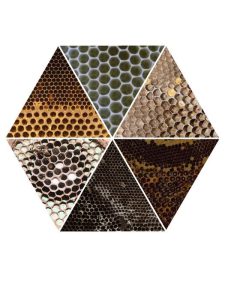
IMAGE: PHOTO CREDIT: MICHAEL L. SMITH
At first glance, the hexagonal cells build by honey bees and social wasps may seem similar, but they are significantly different. Honey bees build using wax, whereas wasps use paper. Honey bees build their double-sided combs vertically, whereas wasps build single-sided comb horizontally (i.e., the opening of each cell faces downward).
Indeed, the hexagonal cells built by these two groups have independent evolutionary origins. Just like sharks and whales have similar body plans due to their watery environment, bees and wasps build hexagonal cells because the shape maximizes strength and storage area, while minimizing building materials.
But what happens when perfectly hexagonal cells cannot be built? Do bees and wasps fix their building problems in the same way?
In a subset of honey bee and wasp species, workers build two different sizes of hexagons. The smaller cells are used for rearing workers, and the larger cells are used for rearing reproductives; drones and queens. This difference in cell sizes creates an inherent architectural problem: how do you tile two differently-sized hexagons within a single sheet of comb?
To determine how different species solved the same architectural problem, the researchers needed nest images that included both worker and reproductive cells in the same comb.
First-author Dr. Michael L. Smith, Assistant Professor in the Department of Biological Sciences at Auburn University, and Affiliate Member of the Max Planck Institute for Animal Behavior, contacted researchers across the globe for potential images. They then used custom-built software to extract per-cell metrics from 22,745 individual cells.
In some species, like Metapolybia mesoamerica, worker and reproductive cells are the same size, so there was no architectural hurdle to overcome. In other species, like Apis andreniformis, reproductive cells are up to 2.7 times larger than worker cells, which creates a serious building problem – how to combine these wildly different hexagons in an efficient way?
Looking across 10 species, the researchers found that as the scale of the building problem increased (the size difference between worker and reproductive cells), workers began incorporating non-hexagonal cells. These irregular cells were mostly 5- and 7-sided, but they were consistently built in pairs, with the 5-sided cell built on the worker-side, followed by a 7-sided cell on the reproductive side. This pattern was seen in all the honey bee and wasp species that had a cell-size difference to overcome. For a group of insects renowned for their hexagonal cells, this alone was interesting, as it showed that they all rely on the same non-hexagonal configurations.
The researchers then built a mathematical model that would predict, based on the cell-size difference, how many non-hexagonal cells should be incorporated into the worker-to-reproductive transition. Surprisingly, some of the species were consistently performing better than expected. Upon closer investigation, the researchers saw that these species also incorporated intermediate-sized cells into the transition region. The intermediate-sized cells were still hexagonal, but they allowed the insects to “split the difference” and turn the cell-size transition into a series of smaller ones, which didn’t require non-hexagonal cells.
These same building tricks were adopted across all species of bees and wasps investigated. Despite being separated by over 179 million years of evolution, using different building materials, and independent origins of hexagonal cells, these species have all arrived at the exact same solution to this scalable architectural problem.
“Once we were able to plot out all the data, the results were striking – you could see how the bees and wasps used intermediate-sized cells to make a gradual change, but also how consistently the non-hexagonal cells were arranged in the comb” said Michael L. Smith.
This work has implications for how collective systems can build adaptive and resilient structures without centralized control. There is no single bee or wasp “architect” building the entire structure, instead, it is hundreds or even thousands of individuals contributing to the final product.
This work, titled “Honey bees and social wasps reach convergent architectural solutions to nest-building problems,” was published 27 July 2023 in the journal PLOS Biology.
This study was funded by the National Science Foundation, the German Research Foundation, a Packard Fellowship for Science and Engineering, and GETTYLABS.
This manuscript is published in PLOS Biology and is freely available at the following link: http://journals.plos.org/plosbiology/article?id=10.1371/journal.pbio.3002211
We are here to share current happenings in the bee industry. Bee Culture gathers and shares articles published by outside sources. For more information about this specific article, please visit the original publish source: http://journals.plos.org/plosbiology/article?id=10.1371/journal.pbio.3002211
]]>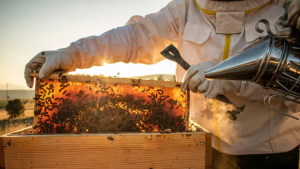
Honey bees are invaluable both for biodiversity and agriculture as they are excellent pollinators, yet their numbers worldwide have been dropping dramatically. The causes include climate change, habitat loss, pesticide use and diseases.
It is in this latter category of threats that entomologists from the University of Florida, the Agricultural Research Service-USDA, Louisiana State University and the University of Nebraska-Lincoln have made marked progress. They have done so by prompting honey bees’ cells to produce free radicals for protecting the insects against a range of potentially deadly viruses.
In field studies researchers used a compound called pinacidil to alter potassium ion channels, a protein found in the cells of bees’ and other iving things. Altering these channels produced slightly more free radicals, they explain.
The scientists gave the drug to honey bee colonies by mixing it into sugar water and drizzling it over their honey comb at night. The bees consumed the sugar water and also fed it to their young, thereby spreading the drug throughout the colony.
The treatment protected bees from six viruses that take their toll on honey bee colonies: Israeli acute paralysis virus, deformed wing viruses A and B, black queen cell virus, and Lake Sinai viruses 1 and 2.
“This approach is especially exciting because it doesn’t just target a specific type of virus but helps with many different viruses,” stresses Daniel Swale, an associate professor in the UF/IFAS entomology and nematology department.
“Additionally, we demonstrated that our treatment works both in the lab and in colonies that each contain 80,000 bees in the field,” he adds. “This is huge because in a hive setting bees are exposed to so many different viruses and stressors, so successfully controlling viruses in that environment is very encouraging.”
While viruses are not the greatest cause of deaths among bees, they can contribute significantly, according to the experts.
“Varroa mites are the number one cause of honey bee losses, but it’s important to point out that varroa mites, aside from physically weakening bees, also transmit viruses to bees. If we can mitigate viruses in honey bee colonies, that would be a big step forward,” says Michael Simone-Finstrom, a research molecular biologist with the ARS Honey Bee Breeding, Genetics, and Physiology Research Lab in Baton Rouge, Louisiana.
In their study the researchers also showed that pinacidil helped more bees survive in colonies infested with varroa mites.
Administering the drug to commercial honey bee hives may work only for some beekeepers as it is fairly expensive. However, this research shows the way in developing other drugs that cost less.
“One of the big take-aways from this study is that potassium ion channels can be a target for improving immune system function in honey bees and possibly other insects. We would like to find a molecule, such as a peptide, or a new technology that has the same effect as pinacidil but is more accessible to beekeepers,” Swale says.
We are here to share current happenings in the bee industry. Bee Culture gathers and shares articles published by outside sources. For more information about this specific article, please visit the original publish source: Scientists Develop a Drug to Protect Honey Bees from Viruses – The Good Men Project
]]>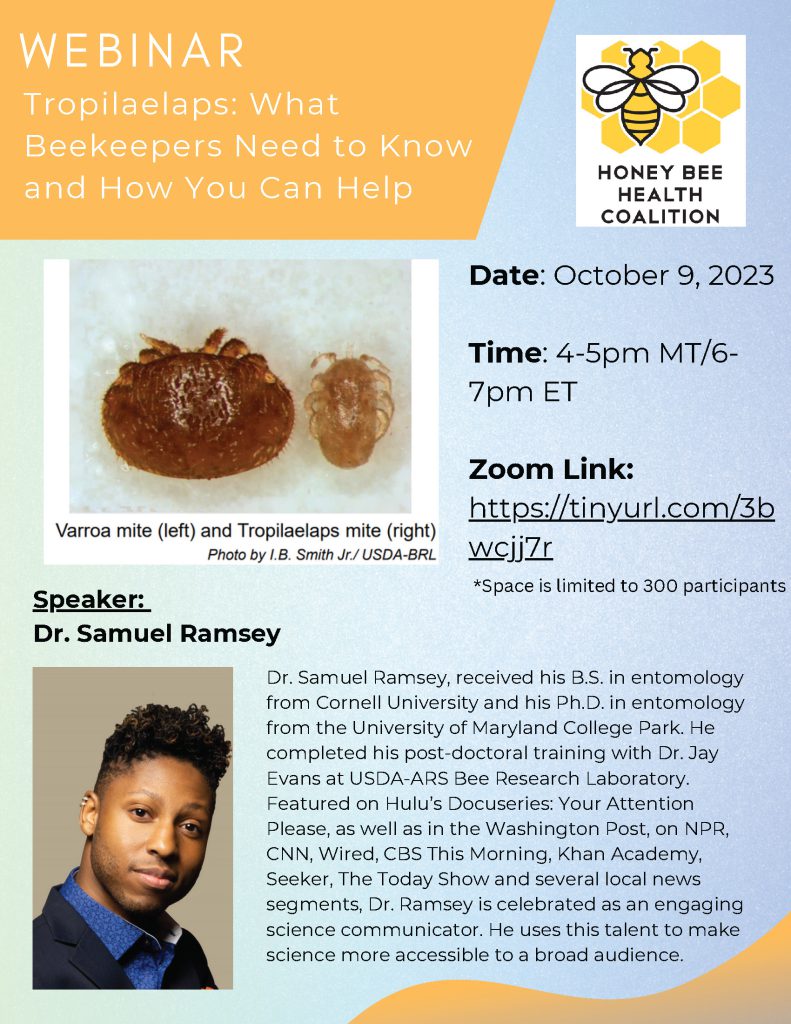
Link:
]]>The sweet stuff can help with burns, coughs, anxiety and more
By Alison Gwinn,
AARP
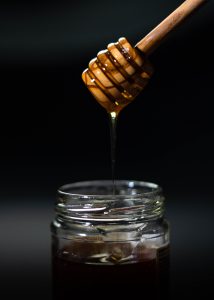
Photo by Daily Slowdown on Unsplash
Honey’s benefits have been touted since antiquity — and it turns out the ancient Greeks and Romans were onto something: Honey really can hit the sweet spot when it comes to our health.
Though honey — a sweet, sticky liquid made by honeybees from flower nectar — is technically a sugar, “it’s also really rich in a lot of different bioactive substances,” says Mayo Clinic registered dietitian (and hobbyist beekeeper) Joy Heimgartner. Those include a range of good-for-you minerals, probiotics, enzymes, antioxidants and other phytochemicals.
There are four common types of honey: Raw honey is defined by the National Honey Board as “honey as it exists in the beehive or as obtained by extraction, settling or straining without adding heat.” Manuka honey, produced from the flowers of manuka trees, is known for its unique antibacterial properties, attributed to a compound called methylglyoxal, says Jordan Hill, lead registered dietitian for Top Nutrition Coaching.
Organic honey is produced without the use of synthetic chemicals, pesticides or GMOs. And locally produced honey has been reported to provide relief from seasonal allergies to local pollen, though scientific evidence to support that claim is limited, says Hill.
According to Hill, honey can be substituted for sugar in recipes, but remember: It has a distinctive flavor (which varies depending on the source flowers); it’s sweeter than sugar (the general rule of thumb is to use ¾ to 1 cup of honey for every 1 cup of sugar); it’s a liquid, so you may need to cut back on other liquids or slightly increase the dry ingredients in a recipe; and it browns more quickly than sugar (so reduce the oven temperature by 25°F).
But whatever way you use honey — in a recipe or as a condiment — always keep in mind that it is a sweetener. “Honey is a supersaturated sugar solution, and we should limit added sugars of all types,” says Heimgartner. Still, “if you’re looking for a sweetener that has more to offer, honey is fantastic.” Here are six reasons why.
- Honey doesn’t raise your blood sugar as rapidly as white sugar
“Honey is metabolized differently from white sugar and produces less of a sugar spike,” says registered dietitian and nutritionist Dawn Jackson Blatner, author of The Flexitarian Diet. “Research suggests that honey may enhance insulin sensitivity and may support the pancreas, the organ that produces insulin.” A 2018 review of preliminary studies points to honey’s “hypoglycemic effect” and use as a “novel antidiabetic agent that might be of potential significance for the management of diabetes and its complications.”
And a 2022 study out of the University of Toronto found that honey improves important measures of cardiometabolic health, including blood sugar, cholesterol and triglyceride levels, especially if the honey is raw and from a single source.
- Honey can help with wound or burn therapy
“Honey has been used for wound healing for centuries, and certain types of honey, like medical-grade honey, have shown potential in wound management due to their antimicrobial properties and ability to promote healing,” says Hill, who nonetheless advises consulting health care professionals for appropriate wound care. Heimgartner, a board-certified oncology specialist, says, “There’s actually a lot of evidence that using honey during oral cancer radiation treatment helps to prevent some of the nasty side effects of mucositis,” or inflammation of the mouth.
How does it work? “Research suggests that honey prevents or controls the growth of bacteria on the wound, helps to slough off dead tissue and microorganisms, and transports oxygen and nutrients into a wound for quicker healing,” says Blatner.
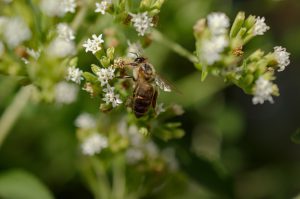
Native plants and naturalistic perennials attract bees and other pollinators.
Create Your Own Pollinator Garden
If you want to create your own pollinator garden for bees to forage in, consider these tips from Emily Erickson, postdoctoral researcher at the University of California, Davis, department of evolution and ecology.
- Opt for native plants or naturalistic perennials.
- Choose plants of varying colors, shapes and bloom times so you can support a variety of pollinators throughout the season.
- Avoid double-flowered varieties (those with extra petals) or plants that look drastically different from their wild relatives.
- Avoid pesticides.
- Leave areas in your yard that can serve as nesting habitats, such patches of bare soil, brush, twigs or woody stems, where many native pollinators make their homes.
- Which plants are right for you depends on your location and climate, so ask your local nursery for advice — or simply walk through a nursery and notice which plants seem to attract pollinators.
- Honey is rich in polyphenols, including flavonoids
Why does that matter? Because those two substances have both antioxidant and anti-inflammatory properties, meaning they protect our bodies against oxidative stress, which can manifest as cancer, heart disease or other diseases. But Hill cautions that the polyphenols in honeys can vary significantly, depending on the type of honey and its floral source.
- Honey can be an effective cough suppressant
A 2020 meta-analysis found that honey provides a widely available and inexpensive alternative to antibiotics in controlling cough frequency and severity, though it concluded that further studies were needed. “It is believed that honey’s thick texture and possible antioxidant and antimicrobial properties may provide relief for cough symptoms,” Hill says, but she adds the caveat that honey should never be given to infants under 1 year of age due to a risk of botulism.
- Honey may provide antidepressant or anti-anxiety benefits.
“Research suggests that polyphenol compounds in honey such as apigenin, caffeic acid, chrysin, ellagic acid and quercetin support a healthy nervous system, which may enhance memory and support mood,” says Blatner. Though more study is needed, a 2014 review of research says that one established nootropic (or cognitive-enhancing) property of honey “is that it assists the building and development of the entire central nervous system, particularly among newborn babies and preschool-age children, which leads to the improvement of memory and growth, a reduction of anxiety, and the enhancement of intellectual performance later in life.”
- Honey may support a healthy gut
Early research indicates that “honey has an extra-special ability to support a healthy gut microbiome because it contains both probiotics, or good bacteria, and prebiotic properties, which help good bacteria thrive,” says Blatner, though the evidence is limited. A 2022 paper funded by the National Institute of Health, Malaysia, concluded that “honey bees and honey, which have the potential to be good sources of probiotics and prebiotics, need to be given greater attention and more in-depth research so they can be taken to the next level.”
We are here to share current happenings in the bee industry. Bee Culture gathers and shares articles published by outside sources. For more information about this specific article, please visit the original publish source: https://www.aarp.org/health/healthy-living/info-2023/honey-health-benefits.html
]]>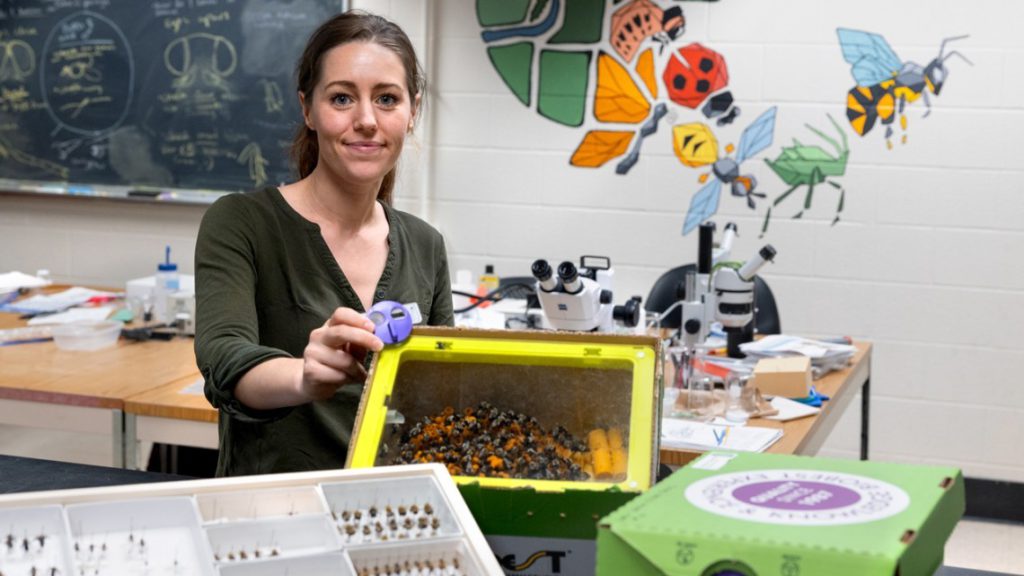
Credit:Ryan Young/Cornell University Researcher Heather Grab holds an excluder next to a commercial bumblebee nest box.
Bumblebee research sparks rapid industry change
By Krishna Ramanujan, Cornell Chronicle
A Cornell study that revealed commercial eastern common bumblebee hives pose a threat to their wild counterparts has led one major pollination company to quickly adapt the bumblebee hive boxes they ship to growers.
The study, which published in February in the Journal of Applied Ecology, showed that brightly colored commercial bumblebee nest boxes attract wild queens, who may be seeking to establish their own nests. When wild queens enter these nest boxes, workers treat them as invaders and kill them, which causes losses of wild hives – and valuable pollinators – in those areas.
The study also found that attaching an existing device – called an excluder – to the nest box doorways, was 100% effective at preventing wild queens from entering hives.
The company, Plant Products, a North American subsidiary of Biobest, has already provided excluders for the entrances and exits of all hives it ships, along with excluder operating instructions. In addition, a product manager has called every client to explain the use of the excluder, which makes a doorway too small for large queens, but big enough for workers.
“For every queen that we’re losing because of this behavior, that’s a whole colony of bumblebees that we’re potentially losing that’s providing really important pollination services later in the season,” said Heather Grab, Ph.D. ’17, senior lecturer in the School of Integrative Plant Science in the College of Agriculture and Life Sciences, and the paper’s corresponding author. Olivia Miller ‘21, who worked on this research as part of her undergraduate thesis, is the paper’s first author.
“From what we see in our data, it’s an average of about 10 queens per colony that are being killed, and that’s just in our study region,” she added.
The study also found that pollination services actually declined at sites where commercial bumblebee colonies were used, compared to areas where they were not used. The scientists suspect that the drop-in services was due to the loss of wild pollinators.
A few months prior to the paper’s publication, co-author Scott McArt, Ph.D. ’12, associate professor of pollinator health in the Department of Entomology (CALS) and manager of the Dyce Lab for Honeybee Studies, contacted Plant Products and Koppert, the only two North American commercial bumblebee suppliers, to tell them about their findings and how excluders offer a simple and effective solution. By the time the paper published in February, Plant Products was already prepared to add excluders to all its shipments. The company has also started research and development to evaluate optimal strategies going forward.
“Frankly, I’ve been blown away by how quickly Biobest responded to the study’s findings and implemented simple but effective companywide changes,” McArt said.
The excluders were originally developed for a completely different purpose, but came in handy when the Cornell researchers made their discovery. Commercial bumblebee nest boxes come with two openings, which serve as an entrance and an exit for the bees. The openings can be slid shut, so if growers spray their crops, they can close the exit to keep bees in but leave the entrance open for bees out foraging to return. Also, if growers want to move a hive, they can close both openings and reopen them in a new location.
Excluders were originally developed to cover just the exit, to prevent commercial hive queens from escaping and mating with wild bees and mixing genes, and/or spreading disease. No one expected they would be needed to keep wild bees out. Now Plant Products is using the excluders on both the entrances.
Overall, bumblebees have been experiencing population declines throughout North America, so saving queens early in spring has a high potential to stem some of those declines, McArt added.
Katja Poveda, associate professor of entomology in CALS, was also a co-author of the paper.
We are here to share current happenings in the bee industry. Bee Culture gathers and shares articles published by outside sources. For more information about this specific article, please visit the original publish source: Bumblebee research sparks rapid industry change | Cornell Chronicle
]]>Reuters
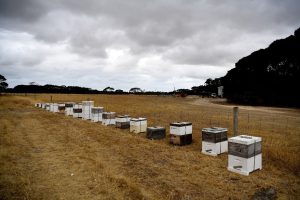
Bee hives at a farm on Kangaroo Island, Australia January 20, 2020. Picture taken January 20, 2020. REUTERS/Tracey Nearmy/File Photo
CANBERRA (Reuters) – The Australian government said it will stop trying to eradicate the Varroa mite, a parasite that kills honey bees, and will instead try to manage its spread, which is likely to make pollination of crops such as almonds more costly.
The decision ends an A$132 million ($85.3 million)eradication plan that has destroyed more than 14,000 hives in southeastern Australia since the mite was discovered there in June 2022.
The federal government said the decision was taken on Tuesday by the National Management Group (NMG), which is driving the Varroa programme nationwide.
In a statement on Wednesday, the New South Wales government, speaking on behalf of the NMG, said non-compliant and illegal movement of hives had spread the parasite further and made it impossible to contain.
Commercial crops including almonds, apples and avocados are dependent on pollination by European honey bees, with huge numbers of hives moved during spring flowering to bring bees to plants.
The Australian government has said a widespread mite infestation could destroy most wild European honey bee nests and managed hives not adapted to Varroa, reducing pollination and causing losses of over A$70 million a year.
“The recent spike in new detections have made it clear that the Varroa mite infestation is more widespread and has also been present for longer than first thought,” the New South Wales government said in a statement.
“The potential to eradicate is no longer possible… We now need to work collaboratively to manage and minimise the impact of Varroa.”
Varroa is a reddish-brown mite around 1 mm in diameter that attaches itself to European and Asian honey bees and feeds on them, weakening them and killing colonies.
The mite also carries viruses and has caused the collapse of honey bee populations around the world.
Varroa does not target native Australian honey bees.
We are here to share current happenings in the bee industry. Bee Culture gathers and shares articles published by outside sources. For more information about this specific article, please visit the original publish source: https://www.reuters.com/world/asia-pacific/australia-abandons-efforts-eradicate-deadly-honey-bee-parasite-2023-09-20/
]]>by Entomological Society of America
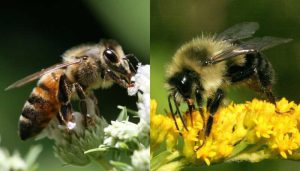
Responsible use of pesticides includes striving to avoid negative effects on the environment, often with an emphasis on protecting bees and other pollinators. A new study, however, finds that many common methods for minimizing pesticides’ impact on bees—even some recommendations on product labels—are backed by minimal scientific evidence. The researchers behind the study, published in the Journal of Economic Entomology, say stronger testing is needed to evaluate which bee-protection measures are truly effective and which ones may be too reliant on conventional wisdom. Moreover, nearly all of the research that has been conducted on these measures has focused on managed honey bees (left) while ignoring wild, native bees such as bumble bees (right) and other pollinators. Credit: (Honey bee photo by Chris Evans, University of Illinois; bumble bee photo by David Cappaert. Both photos via Bugwood.org)
Responsible use of pesticides includes striving to avoid negative effects on the environment, often with an emphasis on protecting bees and other pollinators. A new study, however, finds that many common methods for minimizing pesticides’ impact on bees—even some recommendations on product labels—are backed by minimal scientific evidence.
The researchers behind the study say stronger testing is needed to evaluate which bee-protection measures are truly effective and which ones may be too reliant on conventional wisdom. They share their analysis in a report published in the Journal of Economic Entomology.
Growers are urged to follow a variety of “mitigation measures” meant to protect bees during pesticide applications, such as spraying at night, using specific nozzles on sprayers, or maintaining buffer zones.
“It takes time, money, and effort to follow these rules, so if they are not actually helpful, they are a waste of time,” says Edward Straw, Ph.D., a postdoctoral researcher in the School of Agriculture and Food Science at University College Dublin (UCD) in Ireland and lead author on the study. “If they are helpful, though, they could be applied more widely, to protect bees further.”
Straw and colleague Dara Stanley, Ph.D., assistant professor in applied entomology at UCD, combed published, peer-reviewed research for studies that evaluated the effectiveness of any kind of mitigation measure in reducing a pesticide’s impact on bees. Just 34 studies matched their criteria, spread across a wide range of measures—but largely focused on just one kind of bee.
“Almost all research was centered around protecting honey bees. However, honey bees are a managed species that is not endangered,” Straw says. “When we try to protect bees, we really want to be protecting wild, unmanaged bee species, as these are the species which are in decline.”
Few mitigation measures had more than one or two studies evaluating their effectiveness, and methods of testing varied. For instance, some studies tested for direct overspray while others tested for longer-term pesticide residues. And just three studies among Straw and Stanley’s review evaluated measures frequently found on pesticide labels.
“Least researched was testing on how you time a pesticide spray, be that time of day or time of year,” Straw says. “There’s good reason to believe that if you change when you spray, you could avoid peaks in bee activity. Yet surprisingly no one has really researched if this idea works. This is odd, as it’s a very common mitigation measure and not overly hard to test.”
Other mitigation measures tested in existing studies included how pesticides are applied (e.g., spray parameters or planting methods for pesticide-coated seeds), buffer zones, removing flowering weeds before spraying, direct interventions for managed bees (e.g., moving or covering colonies), and applying pesticides only in certain weather conditions or during certain crop stages.
A newer method had the most studies (12) investigating its potential: repellent additives to pesticide sprays, which encourage bees to avoid a recently sprayed crop. Several compounds have shown promise in lab testing, but all 12 studies tested repellency for honey bees only, and none were tested in formulation with a pesticide—only on their own.
“It is an interesting idea, but it is not yet ready to be used,” says Straw. “It would need to be tested on a diversity of bee and insect species, as if it is only repellent to one or two species, all the other bees would still be exposed to the pesticide.”
In sum, Straw and Stanley say too much hinges on bee-protective measures for them to be weakly supported. Bees play a critical role in both natural ecosystems and agriculture, and the presumption that mitigation measures are effective can be factored into decisions to authorize pesticides for use. Rigorous scientific evaluation of these measures is imperative, they say.
“The main limitation is that these studies need to be big, well-funded pieces of research. To test changes to how a pesticide is applied to a crop, you need to have a crop, a pesticide sprayer, and someone licensed to spray. All of that is expensive and time consuming, making it out of reach for most scientists,” says Straw.
But, if such research can be generated, there’s reason to believe it will have immediate positive impacts. In related research Straw and Stanely published earlier this year, compliance with pesticide regulations and guidelines among farmers in an anonymous survey was high. “We know that these mitigation measures are being followed,” says Straw. “We just do not know if they are helpful yet.”
More information: Edward Straw et al, Weak evidence base for bee protective pesticide mitigation measures, Journal of Economic Entomology (2023). DOI: 10.1093/jee/toad118
Journal information: Journal of Economic Entomology
Provided by Entomological Society of America
We are here to share current happenings in the bee industry. Bee Culture gathers and shares articles published by outside sources. For more information about this specific article, please visit the original publish source: DOI: 10.1093/jee/toad118
]]> Online Beekeeping Course with Rutgers University!
Online Beekeeping Course with Rutgers University!
Make a beeline to Rutgers University for our online beekeeping course this fall! From disease and mite prevention to honey production and harvesting, Bee-ginner Beekeeping will cover everything you need to know to further your hobby or get your business off the ground! Topics include:
- Bee Biology
- Queen Bee Purchasing
- Disease and Mite Prevention
- Hive Assembly and Management
- Honey Extraction
- Rules and Regulations
- And Much More!
Our instructors are Mike Haberland, an Associate Professor and County Environmental Agent with Rutgers Cooperative Extension, and Debbie Haberland, a teacher, marine biologist, and owner of Working Girls Meadows apiary. They will be on hand every step of the way to answer your questions and guide your learning. Complete the 14 – 16 hours of online course work at your own pace and attend a live review and Q&A session with our instructors. Certificates will be issued for successful completion of this course.
]]>- By HARLEIGH CUPP Daily News-Record
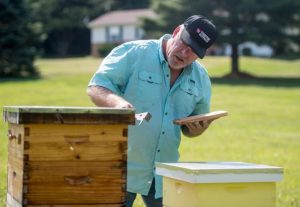
Barry Gibson, owner of Hannah Bee Apiary, inspects his hives.
A gentle humming filled the air surrounding 12 stacked wooden hives — some painted in pastel pink, blue and yellow — while Barry Gibson lifted the lids to peek in on his treasured honeybees.
Hannah Bees Apiary has a story as simple and sweet as the honey its more than 600,000 bees produce each year.
Gibson is a retired U.S. Navy corpsmen of more than 20 years that served on the front lines in Iraq during several different deployments. He peaked an interest in bees and read through several books about apiculture before having the opportunity to take free classes through Michigan State University as a serviceman.
His education certainly did not go to waste, as Gibson rattled off tidbits about the world of bees that he had grown so fascinated by.
He met Hannah Wills in 2019 and moved to their home in Harrisonburg the following year. Coincidentally, Wills father kept bees growing up and so she encouraged Gibson to start a few of his own in their backyard. He listened and what started as a hobby hive two years ago has grown into a vision for starting a small business.
Last month, Gibson received a $1,000 scholarship through a partnership of Tractor Supply Company and the Farmer Veteran Coalition that he had applied for earlier in the year. As one of 60 Veteran farmer honorees from across the nation, he plans to use the funds to construct a storage building for his beekeeping supplies — which are currently housed under the carport — and to expand his apiary to have hives in other locations.
Gibson’s real dream, he said, is to open a coffee shop as a place to display Hannah’s artwork and provide a space for veterans — and anyone else in the community — to gather and share “old war stories.” Honey is how he plans to get there.
“I didn’t start this to make a profit,” explained Gibson. “I have PTSD, and it helps me a lot just being up there [with my bees]. They have their own little world, and it’s soothing to me just to be up there.”
Get in touch with Hannah Bees Apiary and follow Gibson’s farm journey online through his new website at www.hannahbeesapiary.com.
We are here to share current happenings in the bee industry. Bee Culture gathers and shares articles published by outside sources. For more information about this specific article, please visit the original publish source: https://www.dnronline.com/news/harrisonburg-veteran-wins-tractor-supply-grant-to-expand-apiary/article_7e9ae844-4d1f-56ba-a432-e92939d28057.html
]]>/ By Lucas Forbes, Bronwyn Herbert, Emily Doak, and Tina Quinn
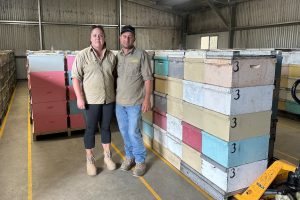
Beekeepers Denille Banham and Daniel Costa stand to lose all their hives due to varroa mite. (ABC News: Tina Quinn)
As authorities race to control the outbreak of varroa mite in Australia’s bee population, many beekeepers are saying it is time to learn to live with the mite.
Key points:
- A US bee health group is working on a “varroacide” to defeat the pest
- A New Zealand beekeeper says the worst effects of varroa mite were over in two years
- Beekeepers losing hives to euthanasia in Australia are calling for a policy shift from eradication to management
But what would that look like?
More than a year after varroa mite was first found at the Port of Newcastle, detections of the parasite have ramped up.
In recent weeks, thousands of beehives have been quarantined or euthanased after the mite was detected in hives in Kempsey on the NSW mid-north coast, many of which were delivered to parts of the Sunraysia and Riverina districts for almond pollination.
With Australia the only continent in the world where varroa has not taken hold, authorities have maintained a policy of eradication.
Varroa mites can destroy entire hives. (Supplied: Gilles San Martin)
For Kempsey beekeepers Denille Banham and Daniel Costa, the eradication strategy means their hives will be destroyed after varroa was found in some hives taken to Nericon, near Griffith, for the pollination season.
They have 750 hives in the eradication zones and 480 will have to be destroyed.
“Your 23 years of hard work, blood, sweat and tears, just all gone,” Mr Costa said.
Beekeepers are now calling for Australia to move towards managing the mite and living with it, instead of trying to eradicate it.
How is varroa mite managed?
The United States has been living with varroa mite since the late 1980s, when the pest was accidentally introduced to Florida.
The Honey Bee Health Coalition (HBHC) teaches beekeepers how to manage varroa mite and invests in research into developing pesticides that could kill the pest.
HBHC facilitator Matthew Mulica said varroa mite was so common in North America that if any hive did not have it now, it would within the next year.
That is why American beekeepers test for varroa two to four times a year.
If there are more than three mites per 100 bees, the coalition says beekeepers should start control measures immediately.
It is crucial to identify varroa to stop them spreading.
“If you do nothing, then in their last dying breath bees will fly off and infect other hives around you,” Mr Mulica said.
Regular testing carried out
One of the costs of management is hiring people to test hives and apply treatments.
Tumut beekeeper John Casey estimated his labour bill would double under a management policy, but said that would be preferable to staying with eradication.
“We’ve got 2,000 hives up at Euroley in the red zone. We don’t know if they’re going to let us move them or euthanase them,” he said.
“It’s a big loss of the bees and also the income we could make off them for the next couple of years.”
Hundreds of Belinda and John Casey’s hives have been impacted by measures aimed at controlling varroa mite. (ABC Rural: Emily Doak)
In the US, beekeepers can use chemical treatments to kill the mites, and there are some non-chemical techniques as well that interrupt the life cycle of the hive and slow varroa down.
Since varroa mite grows in the pupa of bees, producers can also remove the queen from the hive temporarily to reduce the number of pupa and cut down the opportunities for the mite to grow.
Mr Mulica said the HBHC was working with scientists in the US, Canada and Spain to create a “varroacide” to control the pest.
“We’re looking at all of these things and testing different compounds to find that next miracle molecule, if you will,” he said.
Varroa-resistant bees are also being developed which attack mites or kick infested bees out of the colony.
Silver linings in New Zealand
New Zealand beekeeper Barry Foster said the varroa mite outbreak in 2000 had put up to a third of beekeepers out of business, but there was a silver lining for those who remained.
Around the world varroa mites have killed off almost all the feral bees — the ones bred by beekeepers that escape into the wild.
Feral bees pollinate a lot of crops for free, but with fewer hives in the wild there is more demand for commercial pollination services, and that is what happened in New Zealand.
Mr Foster said beekeepers were paid more for their services and the industry recovered in just a couple of years.
“It was a fairly quick turnaround. Probably within a year or two we had gone through the most difficult learning and mental health period,” Mr Foster said.
He said the beekeeping industry had to adapt.
“You have to be a better beekeeper because of varroa and more on your game and better at planning,” he said.
We are here to share current happenings in the bee industry. Bee Culture gathers and shares articles published by outside sources. For more information about this specific article, please visit the original publish source: Bee pest varroa mite common in New Zealand and the US where beekeepers have learned to live with it – ABC News
]]>/ By Joanna Prendergast, Sophie Johnson, and Belinda Varischetti
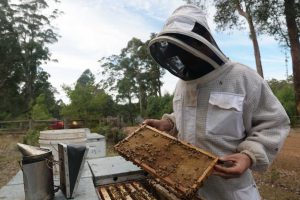
Pemberton beekeeper Mike Cernotta says WA needs to take the varroa threat more seriously. (ABC South West WA, Jon Daly)
West Australian honey producers say they are increasingly anxious about the spread of the destructive varroa mite across New South Wales and fear complacency has left the state’s industry ill-prepared for an outbreak.
Key points:
- As varroa spreads in NSW, the WA beekeeping industry is divided over whether eradication is still possible
- There are fears traffic moving from the east will inadvertently transport the destructive mite into WA
- But authorities say they are “incredibly confident” it can be kept out.
Varroa destructor attacks European honeybees and is regarded as one of the greatest threats to Australia’s honey and honey bee pollination plant industries.
It was detected in sentinel hives in NSW in June last year, but has spread to several new locations in recent weeks, prompting debate about whether eradication is possible, or if NSW should transition to a varroa management policy.
Pemberton beekeeper and WA Bee Industry Council vice chair Mike Cernotta said there was a “huge risk” of varroa entering WA through traffic on the east-west freight link or through swarms of feral bees, and the state was not prepared.
“We had a national blitz where we encouraged beekeepers all over the nation to do alcohol washes, which is the primary detection tool to look for varroa, and unfortunately the uptake in WA was relatively poor … I think it’s complacency,” he said.
“We are pleading with WA beekeepers to do the minimum.
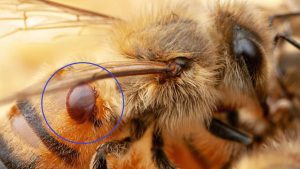
Varroa mite was first detected in Australian in June last year. (ABC Great Southern: Sophie Johnson)
“Time is ticking … the risk is growing, and we really need people to get serious about biosecurity, because otherwise we may find ourselves in a similar situation to NSW where we are scrambling to try and get on top of this pest. ”
Mr Cernotta said he supported eradication attempts continuing in NSW.
“I’d be lying if I said we didn’t have extreme levels of anxiety, because there is nothing we can do other than sit and watch,” he said.
“It’s devastating to see beekeepers facing [hive destruction], but the reality is they’re taking a hit for the rest of the nation’s beekeepers.”
Moving forward with varroa
Kim Fewster has been in the honey industry for 50 years, selling into a range of international markets…
To read the complete article go to; WA honey industry fears biosecurity ‘complacency’ has left state ill-prepared for a varroa mite outbreak – ABC News
We are here to share current happenings in the bee industry. Bee Culture gathers and shares articles published by outside sources. For more information about this specific article, please visit the original publish source: WA honey industry fears biosecurity ‘complacency’ has left state ill-prepared for a varroa mite outbreak – ABC News
]]>This questionnaire is produced by the Nutrition Task force of COLOSS that gathers worldwide researchers interested in bee nutrition (link).
The result of the questionnaire will permit to increase knowledge about:
- How is feeding used across time and space
- How beekeepers perceive feeding
- Malnutrition (including starvation) risks, i.e., when do bees starve? Which are the main nutritional stress factors?
- Future feeding paths: what should be pursued or avoided in the future?
The anonymised results of this questionnaire will be shared to those who completed this questionnaire as well as key stakeholders.
Please see here for further information on data privacy policies.
]]>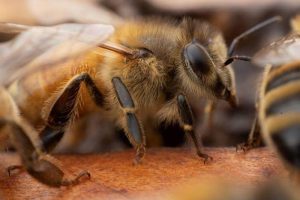 Bees make decisions better and faster than we do, for the things that matter to them
Bees make decisions better and faster than we do, for the things that matter to them
In a new study published in the Journal eLife, researchers shed light on the remarkable decision-making abilities of honey bees, showcasing how millions of years of evolution have finely tuned these insects to make rapid and accurate choices while minimizing risks. This newfound understanding not only deepens our knowledge of insect brains but also offers valuable insights into the evolution of our own cognitive processes and the design of more advanced robots.
Led by Professor Andrew Barron from Macquarie University in Sydney, along with Dr HaDi MaBouDi, Neville Dearden, and Professor James Marshall from the University of Sheffield, the study presents a comprehensive model of decision-making in bees. By outlining the neural pathways that enable swift decision-making, the researchers provide a framework for unraveling the mysteries of these fascinating creatures.
“Decision-making is at the core of cognition,” explains Professor Barron. “It results from evaluating possible outcomes, and animals face countless decisions throughout their lives. Despite possessing brains smaller than sesame seeds, honey bees can make decisions faster and more accurately than humans. To replicate a bee’s abilities, a robot would require the computational power of a supercomputer.”
Professor Barron goes on to highlight the limitations of current autonomous robots, which heavily rely on remote computing support. Drones, for example, lack independent decision-making capabilities and must maintain wireless communication with a data center. This approach, he argues, hampers the prospect of drones exploring distant locations like Mars without external aid, unlike NASA’s rovers that have traveled a mere 75 kilometers over several years.
For honey bees, swift and efficient decision-making is crucial to their survival. Balancing the tasks of finding nectar and safeguarding the hive from predators, bees constantly face decisions regarding which flowers are likely to yield food. While airborne, they are vulnerable to aerial attacks, and once they land to feed, they become susceptible to predators, some of which camouflage themselves as flowers.
The researchers trained 20 bees to recognize five differently colored “flower disks.” Blue flowers consistently contained sugar syrup, green flowers always contained quinine (imparting a bitter taste to bees), and other colors occasionally contained glucose.
“We then introduced each bee to a ‘garden’ where the ‘flowers’ only contained distilled water. We recorded over 40 hours of video, meticulously tracking the bees’ flight paths and measuring the time it took them to make decisions,” explains Dr MaBouDi.
Dr MaBouDi further elaborates on their findings: “If the bees were confident that a flower held food, they swiftly decided to land on it, taking an average of 0.6 seconds. Conversely, if they were confident that a flower did not contain food, they made the decision just as quickly.”
However, when bees were uncertain about a flower’s potential yield, they took significantly longer to decide, averaging 1.4 seconds. The time spent reflected the probability of the flower containing food.
Using these observations, the research team constructed a computer model that emulated the decision-making process of bees, mirroring the structural layout of a bee brain.
“Our study demonstrates complex autonomous decision-making with minimal neural circuitry,” asserts Professor Marshall. “Now that we understand how bees make such intelligent choices, we are investigating how they excel at rapidly gathering and analyzing information. We suspect that bees leverage their flight movements to enhance their visual systems, enabling them to detect the best flowers more effectively.”
Insect behavior, including that of seemingly “simple” animals like bees, offers valuable insights for AI researchers. Through millions of years of evolution, these creatures have developed highly efficient brains with remarkably low power requirements. Professor Marshall, who co-founded Opteran, a company dedicated to reverse-engineering insect brain algorithms for autonomous machine movement, believes that the future of AI in industry will be deeply inspired by biological systems.
By unraveling the secrets of honey bee decision-making, researchers pave the way for breakthroughs in robotics and AI. As technology draws inspiration from nature’s intricate designs, we inch closer to developing machines capable of autonomous decision-making, mirroring the remarkable abilities of these small but mighty insects.
We are here to share current happenings in the bee industry. Bee Culture gathers and shares articles published by outside sources. For more information about this specific article, please visit the original publish source: How Honey Bees Inspire Advanced Robotics and AI – ScienceBlog.com
]]>By Paw Mozter
Wild bees are vital pollinators of many crops and wild plants, but they are facing multiple threats from climate change, habitat loss, pesticides, and diseases.
A new study by researchers from the University of Reading has revealed how warmer springs are causing British bees to wake up earlier, potentially disrupting their synchronization with flowering plants and affecting their survival and reproduction.
The effect of temperature on bee emergence
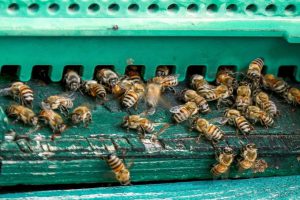
(Photo : KHALIL MAZRAAWI/afp/AFP via Getty Images)
The researchers used a large database of nest materials used by 5,924 species of wild bees over a period of 40 years, and analyzed the relationship between temperature and the dates when bees emerge from their nests, as per Phys.org.
They found that for every 1-degree Celsius rise in temperature caused by climate change, wild bees, such as bumblebees, emerge from their nests 6.5 days earlier on average.
This means that as spring starts earlier and bees become active closer to the start of the year, they may lose sync with the plants on which they depend for food.
This could reduce their chances of finding enough pollen and nectar to survive and produce offspring. It could also affect their ability to pollinate crops effectively, or they may miss crop blossom completely.
The researchers also found that distinct species of bees respond differently to the changing temperature, and that some bees emerge earlier than others.
This could alter the composition and diversity of bee communities and have implications for plant-pollinator interactions.
The implications for crop pollination
The shift in bee emergence could have negative consequences for crop pollination, especially for plants that are heavily dependent on pollination, such as apple trees, as per Daily Mail.
If bees emerge too early or too late, they may not be able to pollinate the crops when they are in bloom, resulting in lower yields and quality.
To prevent this, farmers may need to rely more on managed honeybees, which can be moved around to match crop flowering times. However, this could entail greater costs, which may be passed on to consumers.
Moreover, honeybees may not be able to replace the pollination services provided by wild bees, which are more diverse and adapted to different plants and environments.
To better understand how climate change affects crop flowering times, the researchers have set up a project called FruitWatch, which encourages people to report when fruit trees in their gardens, parks or allotments start to flower.
This could help them monitor how fruit trees respond to changing weather conditions and how this affects their pollination by wild bees.
The study shows that climate change is having a significant impact on the emergence patterns of wild bees in Britain, and that this could affect their survival, reproduction, and pollination services.
The researchers suggested that more research is needed to understand how distinct species of bees and plants cope with the changing temperature, and how this affects their interactions and dependencies.
They also recommend that conservation efforts should focus on protecting and restoring habitats that can provide food and shelter for bees throughout the year.
We are here to share current happenings in the bee industry. Bee Culture gathers and shares articles published by outside sources. For more information about this specific article, please visit the original publish source: Impact of Climate Change on Wild Bees: How They Are Emerging Earlier and What It Means for Pollination | Nature World News
]]>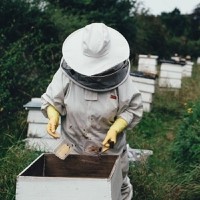
US-based researchers have successfully treated honey bees with a novel immune system booster for deadly viruses causing losses of the critical pollinator on a global level. Honey bees play a crucial role in our food system and production by pollinating crops, and their population decline, partly caused by viruses, is a direct danger to human health.
The scientists found that bees could fight many viruses when encouraging their cells to produce free radicals.
“This approach is especially exciting because it doesn’t just target a specific type of virus but helps with many different viruses,” says Daniel Swale, senior author of the study and the associate director for training and special projects in the UF Emerging Pathogens Institute and associate professor in the UF/IFAS entomology and nematology department.
“Additionally, we demonstrated that our treatment works in the lab and in colonies containing 80,000 bees in the field. This is huge because, in a hive setting, bees are exposed to so many different viruses and stressors, so successfully controlling viruses in that environment is very encouraging,” says Swale.
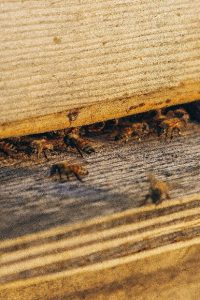
The protein was mixed with sugar water and drizzled over the honeycomb, making it accessible for the bees to consume.
A threatened specie
Michael Simone-Finstrom, a co-author of the study and a molecular research biologist with the ARS Honey Bee Breeding, Genetics and Physiology Research Lab in Louisiana, US, says that “varroa mites [a parasitic mite that attacks honey bees] are the number one cause of honey bee losses, but it’s important to point out that varroa mites, aside from physically weakening bees, also transmit viruses to bees.”
The researchers used a protein found in the cells of bees and most other “living things,” the compound pinacidil, which alters potassium ion channels and produces more free radicals.
“One of the big takeaways from this study is that potassium ion channels can be a target for improving immune system function in honey bees and possibly other insects. We would like to find a molecule, such as a peptide or a new technology that has the same effect as pinacidil but is more accessible to beekeepers,” says Swale.
The protein was mixed with sugar water and drizzled over the honeycomb, making it accessible for the bees to consume. The treatment showed protection from the Israeli acute paralysis virus, deformed wing viruses A and B, black queen cell virus and Lake Sinai viruses 1 and 2.
“While free radicals are often bad for cell health, they can be therapeutic in moderate amounts, as we see in this study. In this case, the additional free radicals signal to the immune system to ramp up, which helps the bees fight off viruses,” says Troy Anderson, a co-author of the paper and a professor of entomology at the University of Nebraska-Lincoln.
“If we can mitigate viruses in honey bee colonies, that would be a big step forward,” Simone-Finstrom adds.
The team of researchers says there are challenges in treating all commercial honey bees, although it “opens the door” to identify other, and maybe more cost-effective, treatments.
We are here to share current happenings in the bee industry. Bee Culture gathers and shares articles published by outside sources. For more information about this specific article, please visit the original publish source: Successful treatment for deadly honey bee viruses found in US study (nutritioninsight.com)
]]>